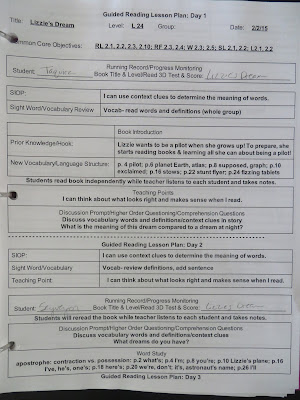Here is a look inside my guided reading notebook!
I always keep my Guided Reading Tips and Tricks flip chart in the outside pocket. I use it to help with planning and during guided reading groups to help with running record scoring and teaching points. Read more about it here!
We used Read 3D testing, so when you open my notebook up, I have some of the Read 3D scoring guides in my left pocket. I refer to these when doing written comprehension with my students so I can make sure they are on track. On the right side, I have the SIOP goal for my lesson.
On the back side of the pocket, I keep any handouts I'm using for that group. This one has a passage from ReadWorks that we were working on that day. The right side has a page where I track the books each group reads and the level, as well as the sight word/vocabulary word and word work for that book.
When you turn the page, I have students reading goals. I cut up sticky notes, wrote students names, and stuck it on their goal.
On the back of the reading goals, I have writing goals for students.
Sample anecdotal notes- please excuse the messy handwriting!! I write quick when taking notes!
After each group's lesson plans, I have a data sheet for each student that tracks their running records- it lists the date, book, level, score, SC, MSV, fluency score and comprehension score.
 I also have a pocket for Read 3D data. I refer to this when making my guided reading plans to make sure I'm working on everything that these students need to be successful.
I also have a pocket for Read 3D data. I refer to this when making my guided reading plans to make sure I'm working on everything that these students need to be successful.
The back pocket of my notebook has extra handouts I have used in my lessons.
Yes, that is duck tape for a label! This was a recycled notebook and someone had written on the plastic part so I had to cover it somehow :)
When I taught in the classroom, each student had a marble notebook for guided reading groups. I had students write the title of the book and date, and then we filled the pages with word work and written comprehension.
As a remediation teacher, I had folders for each student.
They kept their work in the front pocket. In the fasteners, we had a goal sheet and two data tracking graphs.
About every month or so (sooner if I felt students were ready and longer if I didn't feel like they were ready), I gave students a reading or writing goal. Then, each time I observed them working on their goal, I'd give them a date. Once they had all their dates filled in, they got a sticker.
 Students also graphed their reading level and fluency levels each month.
Students also graphed their reading level and fluency levels each month.
When I taught in the classroom, I kept all running records in one notebook. When teaching remediation, I found it easier to keep them in the back of each child's folder because then I had everything I needed for that child in one place for conferences with the teachers, as well as parent/teacher conferences.
Activities we completed during fourth quarter.


















































